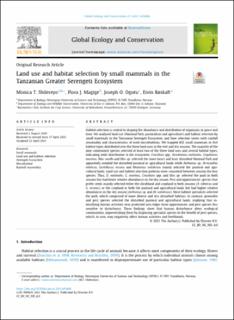| dc.description.abstract | Habitat selection is central to shaping the abundance and distribution of organisms in space and time. We analysed land use (National Park, pastoralism and agriculture) and habitat selection by small mammals in the Tanzanian Serengeti Ecosystem, and how selection varies with rainfall seasonality and characteristics of used microhabitats. We trapped 612 small mammals in five habitat types distributed over the three land uses in the wet and dry seasons. The majority of the nine commonest species selected at least two of the three land uses and several habitat types, indicating wide distribution in the ecosystem. Crocidura spp., Dendromus melanotis, Graphiurus murinus, Mus sorella and Mus sp. selected the more intact and least disturbed National Park and apparently avoided the disturbed pastoral or agricultural lands while Aethomys sp., Arvicanthis niloticus, Gerbilliscus vicinus and Mastomys natalensis mainly selected the pastoral and agricultural lands. Land use and habitat selection patterns were consistent between seasons for four species. Thus, D. melanotis, G. murinus, Crocidura spp. and Mus sp. selected the park in both seasons but had lower relative abundances in the dry season. Pest and opportunistic species that prefer seeds mainly selected either the shrubland and cropland in both seasons (A. niloticus and G. vicinus), or the cropland in both the pastoral and agricultural lands but had higher relative abundances in the dry season (Aethomys sp. and M. natalensis). Most habitat specialists selected the park, which comprised of more diverse and less disturbed habitats. In contrast, generalist and pest species selected the disturbed pastoral and agricultural lands, implying that intensifying human activities near protected area edges favor opportunistic and pest species less sensitive to disturbance. These findings show that human disturbance alters ecological communities, impoverishing them by displacing specialist species to the benefit of pest species, which, in turn, may negatively affect human activities and livelihoods. | en_US |

